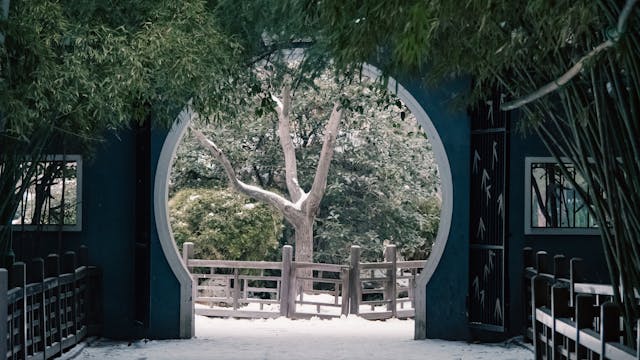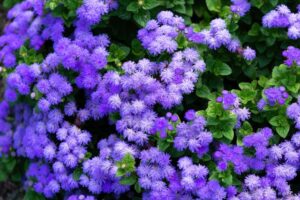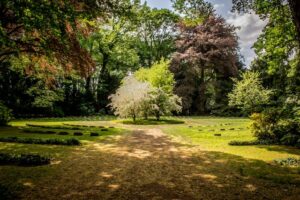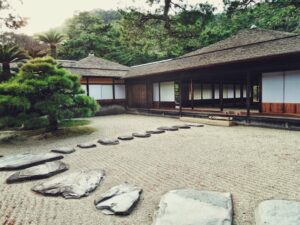Ed and Alice Heathcoat Amory are carrying on a family legacy at Chevithorne Barton by caring for the famed oak tree collection started by his father and the naturalistic garden created by his great-grandmother.
Every garden has a tale to tell. Some have their secrets hidden under freshly painted facades and layers of history. Some see little changes over time; their tales are embodied in weathered brickwork, cherished plants and trees, and the sounds of surrounding conversation.
One such garden is Chevithorne Barton. Its tale, nourished by many generations within the same family, is one of love and loss, willpower and fixation. Nestled in the heart of Devonshire countryside, this exquisite late-Elizabethan manor home was gifted to Ludovic and May Heathcoat Amory in 1911 as a wedding present. Even after the land was given to her grandson Michael in 1966, May dedicated her life to building a garden here, caring for it far into her nineties. He was careful to maintain her beloved garden, but he also added his own touches, including an incredible assortment of oak trees that, by the time his son Ed acquired Chevithorne in 2016, was well-known across the globe.

However, the tale starts on the day May and Ludovic moved there, which was 1911. The pair set about planning a garden at Chevithorne, as there wasn’t much of one before. May worked on the garden by herself when her husband left to fight in the First World War. Nearly every day, the couple would write to one other, discussing their plans for the garden and other topics. “I wish I had witnessed the peak of our Michaelmas daisies.” October 1917: Ludovic wrote, “I always love them with the little Japanese anemones.” He was killed on the Front Line less than a year later, leaving May to raise three little sons. She lost all three of her boys in the Second World War, thus her grief did not stop there. She threw herself into her garden as a way to cope with her loss and put in endless hours honing her vision.
May had created a sequence of terraces for the east of the house’s south-facing slope in the 1930s. Even now, the quaint terraced garden is nearly exactly as she had designed it and as Lanning Roper wrote in Country Life in 1960: “There is a mellow softness, not only of the structural lines but of the stone itself, with its coating of moss and lichens, and there is a stonework of the steps, paths, walls and garden house on the top terrace that is so overgrown with erigerons, campanulas, thymes, and endless other rock plants that all rigidity has been lost… Plants have been permitted to proliferate and spread over time, to the point where a carpet of flowers almost obscures the stone pathways. Lanning may have been describing the garden in its current state. It seems appropriate that the core of the garden stays as formal as May planned, with a beautiful softness that mimics the surrounding hills and terrain, without being too formal.
Living here with his journalist wife Alice Thomson and their four kids, Ed Heathcoat Amory, her great-grandson, recalls, “It was a naturalistic garden at a time when that was quite an innovative thing to do.” “May had a holistic vision for the garden, in my opinion; it should blend in with the countryside rather than stand apart from it.” An iron gate opens from the terrace garden’s lower lawn into the orchard and woodland garden, home to unusual plants and shrubs that flourish on the grassy slopes, including a valuable collection of yellow magnolias. May created an intricate network of streams in this region, rerouting water from the mill leat that runs along the top of the valley and providing a constant sound of flowing water throughout the garden. Once again, Lanning captures the mood well when she says, “This garden is romantic, informal, completely satisfying, and, above all else, unique.”
Michael added his collection of oak trees, which he started in 1984 and is now the biggest of the UK’s two National Collections, to this pastoral setting. Around 440 species and types have colonized the forest garden and two big fields beyond. What started as a hobby for Michael became into a full-fledged passion as he traveled the globe in quest of new variations. According to Ed, “the oak tree is distinctly British and deeply ingrained in our history.” Although there are only two species of oaks native to our country—Quercus robur and Quercus petraea—my father found it interesting and challenging to figure out which of the many oak species exist worldwide would thrive in this environment.

The collection includes some very uncommon species, such as the leathery-leathed Quercus guyavifolia from south-western China, which has silky golden undersides, and the exquisitely etched and textured Quercus leucotrichophora from Nepal. Michael and fellow quercophile James MacEwen, who is now the collection’s curator, published The Oaks of Chevithorne Barton, a book that has descriptions and photographs of all of them. Michael had a clear vision, but he was aware that he would not live to see his idea realized to its full potential. “The garden and surrounding landscape at Chevithorne will have undergone significant changes in half a century,” he wrote. “The landscape, which is dominated by mature oak trees, will have evolved and my grandmother’s plantswoman’s garden will be framed in it.”
Ed and Alice are very conscious of the legacy they have left behind and are resolute in their efforts to expand the oak collection. “Disease and climate change are posing a threat to our native oaks, so it’s critical to consider other species that may be able to flourish in a warmer climate,” adds Ed. They are growing new oaks, meeting other aficionados, and dreaming of family vacations to far-off locations in quest of new species while working with James and head gardener Will Woodman. Due to the epidemic, they were able to spend more time at Chevithorne and get a better understanding of how the home, garden, and surrounding terrain all work together. The next step, according to Ed, is to merge the two inheritances that we have—one from my father and the other from my great-grandmother. To create connections between the various sections and to open up vistas, they have planted a new hamamelis walk and designed new paths throughout the garden and arboretum. The garden will inevitably alter; trees will fall and new chances will present themselves, but major overhauls are not in the cards. Both the place’s distinct character and the memory of those who created it will be maintained.
May created these stone stairs, which are covered with erigeron, moss, and other self-seeding plants, precisely as they were in her day, next to a Myrtus communis in full flower.
Gazing upwards up the terraces, an abundance of self-seeded flora cascades over the stones, almost concealing the ancient walls. Box and other shrubs are neatly trimmed into domes to provide contrasting definition.

A broad herbaceous border on the lowest terrace is planted with tulips, aquilegias, alchemilla, and other cottage-garden varieties. A wall-mounted gate at the far end of the grass opens onto the wooded garden.
In the lower forest area, where short, appealing trails wind through a sea of white-flowered wild garlic and swaths of bluebells in spring, a stunning Fagus sylvatica ‘Rohanii’ offers dappled shadow. This is a beautiful location to stroll through, filled with the sounds of singing and flowing water from May’s intricate system of little waterfalls and cascading streams.
Michael planted a lot of yellow magnolias in the garden, including this one called “Solar Flair.”
The unusual Nepalese oak, Quercus leucotrichophora, has deeply engraved bark.
By establishing hundreds of oak species in an area beyond the woodland garden, Michael established a new arboretum.



